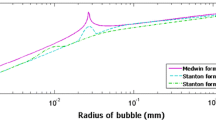Abstract
A passive acoustic method for estimating the flow of underwater bubble gas emissions for shallow water areas has been proposed and tested. The method is based on the connection between the frequency of the acoustic signal produced by a gas bubble when it separates from the underwater outlet channel and the size of the bubble. In the conducted laboratory experiments acoustic signals with frequencies in the range from 2.7 to 0.4 kHz were recorded during generation of bubbles with a size from 2 to 15 mm within the fluid. The analysis of acoustic recordings made near existing shallow-water seeps in Laspi Bay showed a series of short audio signals produced by the released methane bubbles of 0.5–2s duration, grouped into packages containing approximately ten pulses. For the two investigated seeps, the frequency peaked at 1 and 1.4 kHz. According to a theoretical estimate, the bubbles generating such a signal are 7 and 5 mm in diameter, respectively. Taking the intensity of the bubble discharge into account, the calculated gas flows were 40 and 6 liters per day, respectively.
Similar content being viewed by others
References
V. N. Egorov, Yu. G. Artemov, and S. B. Gulin, Methane Seeps in the Black Sea: Environment-Forming and Ecological Roles, Ed. by G. G. Polikarpov (EKOSI-Gidrofizika, Sevastopol’, 2011).
A. Yu. Lein and M. V. Ivanov, Biochemical Cycle of Methane in the Ocean (Nauka, Moscow, 2009).
V. G. Bondur and T. V. Kuznetsova, in Aerospace Monitoring of Oil and Gas Industry Facilities, Ed. by V. G. Bondur (Nauchnyi Mir, Moscow, 2012), p. 272.
L. Dimitrov, Cont. Shelf Res. 22, 2429 (2002).
G. I. Tkeshelashvili, V. N. Egorov, Sh. A. Mestvirishvili, G. Sh. Parkhaladze, M. B. Gulin, S. B. Gulin, and Yu. G. Artemov, Geochem. Int. 35, 284 (1997).
A. A. Pasynkov, E. P. Tikhonenkov, and Yu. V. Smagin, Geol. Polezn. Iskop. Mirovogo Okeana, No. 1, 77 (2009).
M. Römer, H. Sahling, T. Pape, et al., Mar. Geol. 319–322, 57 (2012).
I. Leifer, J. R. Boles, B. P. Luyendyk, and J. F. Clark, Environ. Geol. 46, 1038 (2004).
Yu. G. Artemov, Candidate’s Dissertation in Geography (Kovalevsky Inst. of Biology of the Southern Seas, Sevastopol’, 2014).
A. Vazquez, R. Manasseh, and R. Chicharro, Chem. Eng. Sci. 131, 187 (2015).
R. P. Dziak et al., Deep Sea Res., Part II 150, 210 (2018).
G. Marinaro, G. Etiope, N. L. Bue, P. Favali, et al., Geo-Mar. Lett. 26, 297 (2006).
S. M. Wiggins, I. Leifer, P. Linke, and J. A. Hildebrand, Mar. Pet. Geol. 68, 776 (2015).
M. Minnaert, Philos. Mag. 16, 235 (1933).
H. P. Johnson, U. K. Miller, M. S. Salmi, and E. A. Solomon, Geochem. Geophys. Geosyst. 16, 3825 (2015). https://doi.org/10.1002/2015GC005955
J. Schneider von Deimling et al., Limnol. Oceanogr.: Methods 8, 155 (2010). https://doi.org/10.4319/lom.2010.8.155
M. M. Makarov, Candidate’s Dissertation in Geography (Limnological Inst., Siberian Branch, Russ. Acad. Sci., Irkutsk, 2016).
T. V. Malakhova, T. A. Kanapatskii, V. N. Egorov, L. V. Malakhova, Yu. G. Artemov, D. B. Evtushenko, S. B. Gulin, and N. V. Pimenov, Microbiology 84, 838 (2015).
B. I. Samolyubov, I. N. Ivanova, A. A. Budnikov, and A. I. Tsvetkov, Moscow Univ. Phys. Bull. 70, 536 (2015). doi https://doi.org/10.3103/S0027134915060168
A. O. Maksimov, B. A. Burov, and A. S. Salomatin, Podvodnye Issled. Robototekh., No. 2, 49 (2016).
I. E. Karaichev, in Proc. 3rd Int. Conf. “Progress in Engineering Sciences in the Modern World,” Voronezh, Russia, 2016, p. 91.
S. M. Gorskii, A. Yu. Zinov’ev, and P. K. Chichagov, Akust. Zh. 34, 1024 (1988).
Funding
This work was carried out within the state assignment Molismological and biogeochemical foundations of marine ecosystems homeostasis of A.O. Kovalevsky Institute of Biology of the Southern Seas of RAS (state registration number AAAA-A18-118020890090-2) and supported by Russian Foundation for Basic Research (project No. No18-45-920057 p_a).
Author information
Authors and Affiliations
Corresponding authors
Additional information
Russian Text © The Author(s), 2019, published in Vestnik Moskovskogo Universiteta, Seriya 3: Fizika, Astronomiya, 2019, No. 6, pp. 106–112.
About this article
Cite this article
Budnikov, A.A., Malakhova, T.V., Ivanova, I.N. et al. Application of a Passive Acoustic Method for Detection and Estimation of Shallow-Water Bubble Gas Emissions. Moscow Univ. Phys. 74, 690–696 (2019). https://doi.org/10.3103/S0027134919060109
Received:
Revised:
Accepted:
Published:
Issue Date:
DOI: https://doi.org/10.3103/S0027134919060109




